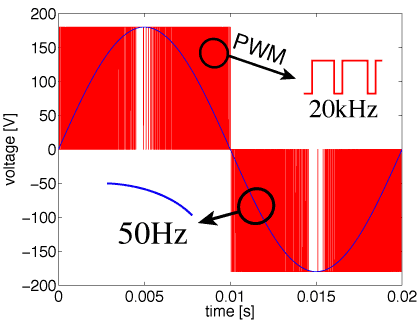Multirate

Highly integrated electric cicuits show a phenomenon called latency. That is, a processed signal causes activity only in a small subset of the whole circuit (imagine a central processing unit), whereas the other part of the system behaves almost constant over some time - is latent. Such an electric system can be described as coupled system, where the waveforms show different time scales, also refered to as multirate.
More generally, any coupled problem formulation due to coupled physical effects, may cause a multirate problem: image the simulation of car driving on the road, there you need a model for the wheel, the chassis, the dampers, the road,... (cf. co-simulation). Again each system is covered by their own time constant, which might vary over several orders of magnitude comparing different subsystems.
Classical methods cannot exploit this multirate potential, but resolve everything on the finest scale. This causes an over sampling of the latent components. In constrast, Co-simulation or especially dedicated multirate methods are designed to use the inherent step size to resolve the time-domain behaviour of each subystem with the required accuracy. This requires a time-stepping for each.
Group members working in that field
- Andreas Bartel
- Michael Günther
Former and ongoing Projects
Cooperations
- Herbert de Gersem, K.U. Leuven, Belgium
- Jan ter Maten, TU Eindhoven and NXP, the Netherlands
Publications
- 1994
492.
Auwera, J. Vander; Holland, J. K.; Jensen, Per; Johns, John W. C.
The \(\nu\)\(_{6}\) band system of C\(_{3}\)O\(_{2}\) near 540 cm\(^{-1}\)
Journal of Molecular Spectroscopy, 163 (2) :529-540
1994
Herausgeber: Academic Press491.
Breidohr, R.; Shestakov, Oleg; Fink, Ewald H.
The a \(^{3}\)\(\Sigma\)\(^{+}\) (a\(_{1}\) 1) → X \(^{1}\)\(\Sigma\)\(^{+}\) (X 0\(^{+}\)) Transitions of BiP, BiAs, and BiSb
Journal of Molecular Spectroscopy, 168 (1) :126-135
1994
Herausgeber: Academic Press490.
Breidohr, R.; Shestakov, Oleg; Fink, Ewald H.
The a \(^{3}\)\(\Sigma\)\(^{+}\) (a\(_{1}\) 1) → X \(^{1}\)\(\Sigma\)\(^{+}\) (X 0\(^{+}\)) Transitions of BiP, BiAs, and BiSb
Journal of Molecular Spectroscopy, 168 (1) :126-135
1994
Herausgeber: Academic Press489.
Breidohr, R.; Setzer, Klaus-Dieter; Shestakov, Oleg; Fink, Ewald H.; Zyrnicki, W.
The a \(^{3}\)\(\Sigma\)\(_{u}\)\(^{+}\) (a\(_{1}\) 1\(_{u}\)) → X \(^{1}\)\(\Sigma\)\(_{g}\)\(^{+}\) (X 0\(_{g}\)\(^{+}\)) Transition of Bi\(_{2}\)
Journal of Molecular Spectroscopy, 166 (2) :251-263
1994
Herausgeber: Academic Press488.
Breidohr, R.; Setzer, Klaus-Dieter; Shestakov, Oleg; Fink, Ewald H.; Zyrnicki, W.
The a \(^{3}\)\(\Sigma\)\(_{u}\)\(^{+}\) (a\(_{1}\) 1\(_{u}\)) → X \(^{1}\)\(\Sigma\)\(_{g}\)\(^{+}\) (X 0\(_{g}\)\(^{+}\)) Transition of Bi\(_{2}\)
Journal of Molecular Spectroscopy, 166 (2) :251-263
1994
Herausgeber: Academic Press487.
Breidohr, R.; Shestakov, Oleg; Fink, Ewald H.
The a \(^{3}\)\(\Sigma\)\(_{u}\)\(^{+}\)(a\(_{1}\) 1\(_{u}\)) → X \(^{1}\)\(\Sigma\)\(_{g}\)\(^{+}\) (X 0\(_{g}\)\(^{+}\)) transition of Sb\(_{2}\)
Chemical Physics Letters, 218 (1-2) :13-16
1994486.
Breidohr, R.; Shestakov, Oleg; Fink, Ewald H.
The a \(^{3}\)\(\Sigma\)\(_{u}\)\(^{+}\)(a\(_{1}\) 1\(_{u}\)) → X \(^{1}\)\(\Sigma\)\(_{g}\)\(^{+}\) (X 0\(_{g}\)\(^{+}\)) transition of Sb\(_{2}\)
Chemical Physics Letters, 218 (1-2) :13-16
1994485.
Breidohr, R.; Setzer, Klaus-Dieter; Shestakov, Oleg; Fink, Ewald H.; Zyrnicki, W.
The a 3Σu+ (a1 1u) → X 1Σg+ (X 0g+) Transition of Bi2
Journal of Molecular Spectroscopy, 166 (2) :251-263
1994
Herausgeber: Academic Press484.
Breidohr, R.; Shestakov, Oleg; Fink, Ewald H.
The a 3Σu+(a1 1u) → X 1Σg+ (X 0g+) transition of Sb2
Chemical Physics Letters, 218 (1-2) :13-16
1994483.
Breidohr, R.; Shestakov, Oleg; Fink, Ewald H.
The a 3Σ+ (a1 1) → X 1Σ+ (X 0+) Transitions of BiP, BiAs, and BiSb
Journal of Molecular Spectroscopy, 168 (1) :126-135
1994
Herausgeber: Academic Press482.
Shestakov, Oleg; Fink, Ewald H.
The a\(^{1}\)\(\Delta\)(a2) state of BiF
Chemical Physics Letters, 229 (3) :273-278
1994481.
Shestakov, Oleg; Fink, Ewald H.
The a\(^{1}\)\(\Delta\)(a2) state of BiF
Chemical Physics Letters, 229 (3) :273-278
1994480.
Shestakov, Oleg; Fink, Ewald H.
The a1Δ(a2) state of BiF
Chemical Physics Letters, 229 (3) :273-278
1994479.
Tashkun, Sergey A.; Jensen, Per
The low-energy part of the potential function for the electronic ground state of NO\(_{2}\) derived from experiment
Journal of Molecular Spectroscopy, 165 (1) :173-184
1994
Herausgeber: Academic Press478.
Tashkun, Sergey A.; Jensen, Per
The low-energy part of the potential function for the electronic ground state of NO\(_{2}\) derived from experiment
Journal of Molecular Spectroscopy, 165 (1) :173-184
1994
Herausgeber: Academic Press477.
Tashkun, Sergey A.; Jensen, Per
The low-energy part of the potential function for the electronic ground state of NO2 derived from experiment
Journal of Molecular Spectroscopy, 165 (1) :173-184
1994
Herausgeber: Academic Press476.
Jensen, Per; Bunker, Philip R.
The Molecular Symmetry Group for Molecules in High Angular Momentum States
Journal of Molecular Spectroscopy, 164 (1) :315-317
1994
Herausgeber: Academic Press475.
Jensen, Per; Bunker, Philip R.
The Molecular Symmetry Group for Molecules in High Angular Momentum States
Journal of Molecular Spectroscopy, 164 (1) :315-317
1994
Herausgeber: Academic Press474.
Jensen, Per; Bunker, Philip R.
The Molecular Symmetry Group for Molecules in High Angular Momentum States
Journal of Molecular Spectroscopy, 164 (1) :315-317
1994
Herausgeber: Academic Press473.
Bednarek, G.; Wayne, R.P.; Wildt, J{ü}rgen; Fink, E.H.
The yield of O\(_{2}\)(b \(^{1}\)\(\Sigma\)\(_{g}\)\(^{+}\), v=0) produced by quenching of O\(_{2}\)(A \(^{3}\)\(\Sigma\)\(_{u}\)\(^{+}\), v=8) by O\(_{2}\)
Chemical Physics, 185 (2) :251-261
1994472.
Bednarek, G.; Wayne, R.P.; Wildt, J{ü}rgen; Fink, E.H.
The yield of O\(_{2}\)(b \(^{1}\)\(\Sigma\)\(_{g}\)\(^{+}\), v=0) produced by quenching of O\(_{2}\)(A \(^{3}\)\(\Sigma\)\(_{u}\)\(^{+}\), v=8) by O\(_{2}\)
Chemical Physics, 185 (2) :251-261
1994471.
Bednarek, G.; Wayne, R.P.; Wildt, Jürgen; Fink, E.H.
The yield of O2(b 1Σg+, v=0) produced by quenching of O2(A 3Σu+, v=8) by O2
Chemical Physics, 185 (2) :251-261
1994470.
Auwera, J. Vander; Holland, J. K.; Jensen, Per; Johns, John W. C.
The ν6 band system of C3O2 near 540 cm-1
Journal of Molecular Spectroscopy, 163 (2) :529-540
1994
Herausgeber: Academic Press- 1993
469.
Graf, J.; Jensen, Per
A Theoretical Model for the Rotation and Vibration of Symmetrical Triatomic Molecules with Strong Coupling Between the Local Stretching Modes
Journal of Molecular Spectroscopy, 159 (1) :175-191
1993
Herausgeber: Academic Press468.
Graf, J.; Jensen, Per
A Theoretical Model for the Rotation and Vibration of Symmetrical Triatomic Molecules with Strong Coupling Between the Local Stretching Modes
Journal of Molecular Spectroscopy, 159 (1) :175-191
1993
Herausgeber: Academic Press
